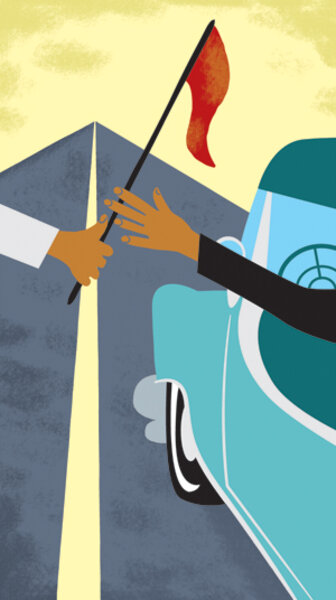Before walkie-talkies, a traffic-flag relay
Loading...
Before there were interstate highways and handy two-way radios, there were narrow roads and flagmen. Oh, how my sisters and I loved the flagmen.
We'd pile into my mother's two-tone green Pontiac sedan and head south out of Michigan. No, not just south, but toward the South. Dixie.
We were going to the Land of Cotton. The land of fried chicken – that we thought we could already smell by the time we got to Cincinnati and rode the bridge over the Ohio River into the town of Covington, Ky.
My father didn't travel with us. He stayed home to work and pay the gasoline bills we'd generate on the 1,400 or 1,500 miles from Detroit to Miami. It was a stretch that is now shortened by those interstates and that has a unique history.
One of Florida's leading developers in the early 1900s was Carl Fisher. He envisioned a highway that would make it easy for Northerners to vacation in the palm-studded paradise he and some others were creating at the bottom of the United States. Fisher's road, called Dixie Highway, was to start in the North and end so very happily on the golden sands of Miami Beach. And it was to have connecting roads feeding into it from all over the Midwest. But only pieces and chunks ever were built, with some remaining to this day.
Fisher's dream was finally realized, somewhat, by Interstate 75, which starts in Michigan's frosty Upper Peninsula and ends in a semitropical coconut grove. But before all that, there we were on a two-lane road in the Pontiac.
Audrey, the elder of my two older sisters, switched off with me now and then for the front passenger seat. Barbara, our other sister, spent most of the journey slumped in a corner in the back, snoring her way through the sights of America.
But Barbara would always wake up as we rolled deeper and deeper into southern Georgia. Somehow she knew we were close to pecan logs and maple pralines. "Stuckey's? Are we near Stuckey's? We're stopping at Stuckey's, aren't we?"
Oh, about the flagmen. See, when there was road construction or repair on a two-lane road then, one lane would be shut down and the other used for alternating flows of traffic in each direction. The way you knew to stop and wait your turn was the signals from the flagman.
He stood at the head of the work site, holding in his left hand a sign that rotated from Stop to Slow. In his right hand was a red flag, about the size of a pillowcase, on a stick a couple of feet long.
As the stream of cars passed by the flagman, he waved them on with his flag, while watching carefully for the last car in the line. Oh, to be the last car.
If yours was the last car, he motioned for you to slow down. He waved for you to open your window if it was closed. And then he handed you the flag. You now were the official courier of vital information.
In the absence of any other form of communication between the first flagman and the one at the other end of the construction zone, it was up to you to report that the current line of cars had passed and the lineup headed in the other direction now could use the road. Your handing of the flag to the second flagman was the all-clear signal that in years to come would be sent to him by two-way radio.
Reaching for the flag as Mother slowed the big car and eased canvas and stick out through the driver's window, the second flagman warmly took it from her and expressed his gratitude for our help. Mother would say something extremely mannerly and overdone, such as, "It was our privilege to serve," or "We appreciate the opportunity to contribute to the community's growth." My sisters and I never saw the community growing. We just got a kick out of carrying the flag.
Barbara, if awake, might join Audrey in a teenage girls' evaluation of the flagman's rugged, outdoors looks. Mother would roll up her window and drive us ever deeper into Dixie.
I'd sit back and dream about the time to come when I'd be able to reach out through the driver's window and grab the flag, playing that vital role in the development of our nation.
But by the time I was old enough to get my license, someone had invented the walkie-talkie, making use of a signal flag unnecessary. A guide at one end could easily tell the guide at the other end that the waiting traffic now could move through.
Carrying the flag – the noble assignment I'd dreamed of – had become just a footnote in the history of road work. Oh, well, the fried chicken was still wonderful.





